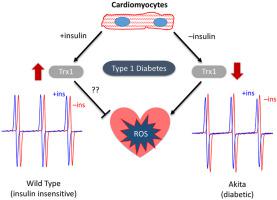Redox Biology ( IF 11.4 ) Pub Date : 2021-09-20 , DOI: 10.1016/j.redox.2021.102140 Satoshi Matsuzaki 1 , Craig Eyster 1 , Maria F Newhardt 2 , Jennifer R Giorgione 1 , Caroline Kinter 1 , Zachary T Young 1 , Michael Kinter 1 , Kenneth M Humphries 2

|
Diabetic cardiomyopathy is associated with an increase in oxidative stress. However, antioxidant therapy has shown a limited capacity to mitigate disease pathology. The molecular mechanisms responsible for the modulation of reactive oxygen species (ROS) production and clearance must be better defined. The objective of this study was to determine how insulin affects superoxide radical (O2•–) levels. O2•– production was evaluated in adult cardiomyocytes isolated from control and Akita (type 1 diabetic) mice by spin-trapping electron paramagnetic resonance spectroscopy. We found that the basal rates of O2•– production were comparable in control and Akita cardiomyocytes. However, culturing cardiomyocytes without insulin resulted in a significant increase in O2•– production only in the Akita group. In contrast, O2•– production was unaffected by high glucose and/or fatty acid supplementation. The increase in O2•– was due in part to a decrease in superoxide dismutase (SOD) activity. The PI3K inhibitor, LY294002, decreased Akita SOD activity when insulin was present, indicating that the modulation of antioxidant activity is through insulin signaling. The effect of insulin on mitochondrial O2•– production was evaluated in Akita mice that underwent a 1-week treatment of insulin. Mitochondria isolated from insulin-treated Akita mice produced less O2•– than vehicle-treated diabetic mice. Quantitative proteomics was performed on whole heart homogenates to determine how insulin affects antioxidant protein expression. Of 29 antioxidant enzymes quantified, thioredoxin 1 was the only one that was significantly enhanced by insulin treatment. In vitro analysis of thioredoxin 1 revealed a previously undescribed capacity of the enzyme to directly scavenge O2•–. These findings demonstrate that insulin has a role in mitigating cardiac oxidative stress in diabetes via regulation of endogenous antioxidant activity.
中文翻译:

胰岛素信号改变糖尿病心脏的抗氧化能力
糖尿病性心肌病与氧化应激的增加有关。然而,抗氧化疗法在减轻疾病病理方面的能力有限。必须更好地定义负责调节活性氧 (ROS) 产生和清除的分子机制。本研究的目的是确定胰岛素如何影响超氧自由基 (O 2 •– ) 水平。通过自旋捕获电子顺磁共振波谱在从对照和秋田(1 型糖尿病)小鼠中分离出的成年心肌细胞中评估了O 2 •–的产生。我们发现 O 2的基础率•–对照和秋田心肌细胞的产量相当。然而,在没有胰岛素的情况下培养心肌细胞导致仅秋田组的O 2 •–产量显着增加。相反,O 2 •–的产生不受高葡萄糖和/或脂肪酸补充的影响。O 2 •–增加的部分原因是超氧化物歧化酶(SOD)活性降低。当存在胰岛素时,PI3K 抑制剂 LY294002 降低了 Akita SOD 活性,表明抗氧化活性的调节是通过胰岛素信号传导进行的。胰岛素对线粒体 O 2的影响•–在接受 1 周胰岛素治疗的秋田小鼠中评估了产量。从接受胰岛素治疗的秋田小鼠中分离出的线粒体产生的 O 2 •–低于接受载体治疗的糖尿病小鼠。对整个心脏匀浆进行定量蛋白质组学以确定胰岛素如何影响抗氧化蛋白表达。在量化的 29 种抗氧化酶中,硫氧还蛋白 1 是唯一一种通过胰岛素治疗显着增强的酶。硫氧还蛋白 1 的体外分析揭示了该酶以前未描述的直接清除 O 2 •–的能力。这些发现表明,胰岛素通过调节内源性抗氧化活性在减轻糖尿病心脏氧化应激方面发挥作用。



























 京公网安备 11010802027423号
京公网安备 11010802027423号